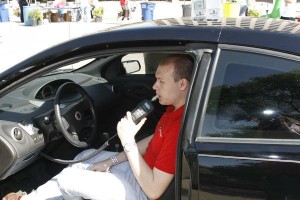OPINION: More Taxes, Less DUIs
If only we could all live in a liquor commercial.
According to alcohol ads, a bottle of vodka can be used as a divining rod for finding the nearest gathering of hot, dancing 22-year-olds.
In these 30 second fantasy lands created by beverage companies, there is no obesity. Even better, no one is over the age of 35, all attractive people are super-friendly, and there’s an awesome party behind every doorway.
The reality of course, is that very few bars and nightclubs manage to pull off this kind of ambience. Many are actually home to a depressing mix of bad habits and bitter memories, with more than a few patrons in various states of ill health (the mental variety included).
Unfortunately, on any given night, a few of them will wander out to their cars alone. Some don’t make it to their destination, possibly even claiming the lives of others in the process.
Of the 30 traffic fatalities on Big Island roadways this year, roughly a third involved the use of alcohol. Our roads have also gotten less safe overall, with 1,080 major accidents so far (a 5.2% increase from 2011.)
Ironically, the same youngsters depicted in booze commercials are the most likely to be involved in alcohol-related deaths. Nationwide, more than half of motor-vehicle fatalities for people under 35 involve the use of alcohol.
Here in the islands, efforts are being made to curb those statistics.
An ignition interlock law went into effect in 2011, giving people arrested for drunk driving the option to have an interlock device installed in their car (instead of the traditional license suspension).

Ignition interlock systems prevent drunks from starting their vehicles. Image courtesy Virginia Commonwealth University.
Ignition interlocks prevent a car from starting if its operator has a blood alcohol level of 0.02% or above. The blood alcohol level is measured via a breathalyzer-type device that is wired into the automobile.
DUI offenders pay for the installation and operation of the system, which totals around $1,500 for 12 months of use. Subsidies are available for welfare recipients.
In the first year after the law took effect, roughly 1,000 locks had been installed, and the number of participating DUI offenders averaged about 10%.
The devices record vehicle ignition attempts and failures, and some of the data they have provided has been alarming. According to the state Department of Transportation, over 3,700 car starts were prevented in 2011 thanks to ignition interlock systems.
Given that many DUI offenders continue to drive after license suspensions, and that only 10% of DUI offenders are using ignition interlocks, it’s conceivable that there are thousands more dangerous automobile trips being made every year that we aren’t aware of.
And that only takes into account known DUI offenders.
Sadly, enforcement of interlock installations isn’t always prompt enough to prevent tragedy. A recent multi-victim fatal accident on the Big Island was allegedly caused by a man who was nearly one month overdue to have an interlock system installed in his vehicle.
The ignition interlock program we now have in place is a good start, but to really bring DUIs to an end, wider adoption needs to be mandated and strongly enforced. In addition, DUI checkpoints and overall traffic enforcement should be expanded to help net offenders (including those using other substances).
Funding such an effort is of course a huge challenge in a cash-strapped state budget. In the prior legislative session, Governor Neil Abercrombie sought a 50% increase in the state’s alcohol tax. It would have raised approximately $20 million per year.
Apart from being unpopular with restaurant and bar owners, the move was unfortunately (for the most part) a cash-grab to fill the state’s budget deficit. Only a fourth of that $20 million total would have gone toward programs aimed at preventing alcohol abuse.
Although such taxes unfairly hit responsible drinkers (who share the burden equally with dangerous individuals), studies have shown they reduce alcohol consumption significantly, even when addiction is taken into account.
More importantly, by some estimates a 10% increase in the price of alcoholic beverages could reduce the probability of drunk driving by between 7 and 8%, and by over 12% among people aged 21 years and younger.
Hawaii’s liquor taxes are already some of the highest in the nation, and tacking on a dollar to the price of a six-pack won’t likely win politicians many votes. But in reality, Abercrombie’s proposal didn’t even come close to that amount. Under his suggested law, the price of beer would have gone up by 30 cents per gallon, or roughly 3 cents per 12 ounce bottle.
But added liquor taxes like these shouldn’t be used to boost state tax coffers. Government-mandated increases in the price of alcohol should be sent directly toward boosting traffic enforcement and the use of ignition interlock devices, to help make island roads safer.
Bars and liquor stores will usually protest such moves, for obvious and understandable reasons. But it’s worth mentioning that Hawaii hasn’t seen an increase in its liquor taxes in 12 years. Additionally, at a national level, alcoholic beverages have actually gotten cheaper in the last few decades.*
Producers of alcoholic beverages seldom take kindly to lower profits, and most will continue to market their products with ads featuring near-comedic levels of slow-motion flirtation and frolic. That’s their business.
Protecting Hawaii’s roads is ours.
*When the price of all other goods is taken into account, the cost of beer fell 20% between 1975 and 1990. The price of wine fell 28% in that same time frame.









